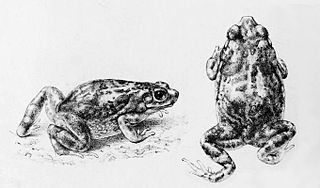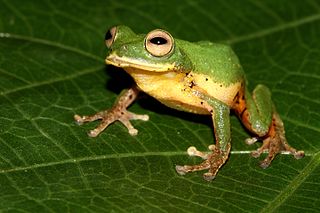
A true toad is any member of the family Bufonidae, in the order Anura. This is the only family of anurans in which all members are known as toads, although some may be called frogs. The bufonids now comprise more than 35 genera, Bufo being the best known.

Duttaphrynus parietalis, commonly known as the Indian toad or ridged toad, is a species of toad found in the Western Ghats of India.

Koyna Wildlife Sanctuary is a wildlife sanctuary and natural World Heritage Site, which is located in Satara district of the Indian state of Maharashtra. Further, this wildlife sanctuary is designated as an Important Bird area. The sanctuary is nested in the Western Ghats, covering an area of around 423.55 km2 (163.53 sq mi), and elevations ranging from 600 to 1,100 m. It was notified in 1985 as a wildlife sanctuary situated in Maharashtra. It forms the northern portion of the Sahyadri Tiger Reserve, with Chandoli National Park forming the southern part of the reserve.

Duttaphrynus hololius, known as Günther's toad, Malabar toad, or rock toad, is an uncommon, rock-dwelling toad found in the Eastern Ghats and Deccan plateau of peninsular India.

Blaira ornata, known with common names ornate toad, Malabar torrent toad or black torrent toad, is a rare and endangered species of toad endemic to the Western Ghats. In 2009, this species along with A. rubigina was shifted from Ansonia to the genus Ghatophryne. The publication of the new genus however did not meet ICZN requirements and a new genus Blaira was created in 2021.

Indosylvirana aurantiaca, commonly known as the golden frog, is a species of frog endemic to the Western Ghats of India. The species is also known as the Trivandrum frog, the common wood frog, or the small wood frog.

Blaira rubigina is a species of toad in the family Bufonidae. It is endemic to the southern Western Ghats, India, and is known from Silent Valley and Wynaad, both in Kerala. Its common names include Kerala stream toad, Silent Valley torrent toad, and red torrent toad.
Duttaphrynus brevirostris is a species of toad in the family Bufonidae. It is endemic to the Western Ghats in India, where it is only known from the state of Karnataka.

Incilius ibarrai is a species of toad in the family Bufonidae. It is found in the central and southern highlands of Guatemala and adjacent Honduras. The specific name ibarrai honors Jorge Alfonso Ibarra (1921–2000), then-director of the Guatemalan National Natural History Museum.

The Japanese stream toad, also known as the Honshū toad, is a subspecies of toad in the family Bufonidae. It was first described by Masafumi Matsui in 1976 during research with Kyoto University as a "moderate to large-sized toad" with a "peculiar color pattern" and "stream-dwelling habits."

Nyctibatrachus beddomii is a species of frog in the family Nyctibatrachidae.

The giant wrinkled frog is a species of frogs in the family Nyctibatrachidae endemic to the Western Ghats of India in the Kudremukh region. Its natural habitats are tropical moist lowland forests and rivers. It is threatened by habitat loss.

Raorchestes flaviventris is a species of arboreal, nocturnal, frog of the family Rhacophoridae. It is endemic to the Western Ghats, South India. Its common name is yellow-bellied bush frog.

Raorchestes glandulosus, also known as glandular bush frog, rough-skinned bush frog, southern bubble-nest frog, and with many other names, is a species of frog in the family Rhacophoridae. It is endemic to the Western Ghats, India, and known from the states of Karnataka and Kerala.

Raorchestes ponmudi is a species of frog in the family Rhacophoridae. It is endemic to the Western Ghats, India and like others in the genus has a life-history that involves direct development, the tadpoles develop into tiny frogs within the egg. Its natural habitat is subtropical or tropical moist montane forests which are threatened habitats. It was first described from Ponmudi hill after which it is named but the species has a wider distribution within the southern Western Ghats and has been recorded in Wynaad, Idukki, and Thiruvananthapuram districts in Kerala, and Valparai in Tamil Nadu. It is a somewhat large species within the genus with males nearly 4 cm long from the tip of the snout to the vent.

Pseudophilautus amboli, the Amboli bush frog, is a rare shrub frog species endemic to the Western Ghats (India). It is found in Amboli and Amba in Maharashtra and in Castle Rock, Londa, Jog Falls-Mavingundi, and Kudremukh-Malleshwaram in Karnataka.

Xanthophryne tigerina, sometimes known as the Amboli toad, is a species of toads. It is endemic to the Western Ghats of India and known only from the vicinity of Amboli in Maharashtra. It was described as a new species in 2009 and placed in a new genus along with its sister species Xanthophryne koynayensis.

Xanthophryne is a small genus of toads in the family Bufonidae. They are endemic to the Western Ghats in Maharashtra, India. Its sister taxon is Duttaphrynus. The name Xanthophryne is derived from two Greek words, xanthos meaning yellow and phryne meaning toad.

Blaira is a small genus of true toads endemic to the southern Western Ghats, India. The genus was erected in 2021 as a valid substitute name for Ghatophryne which was created in 2009 for Ansonia ornata which was found to be distinct enough to warrant its own genus. This was however considered an invalid description as it was published in an only a digital medium ; Ansonia rubigina was moved based on its morphological similarity and distribution.

















